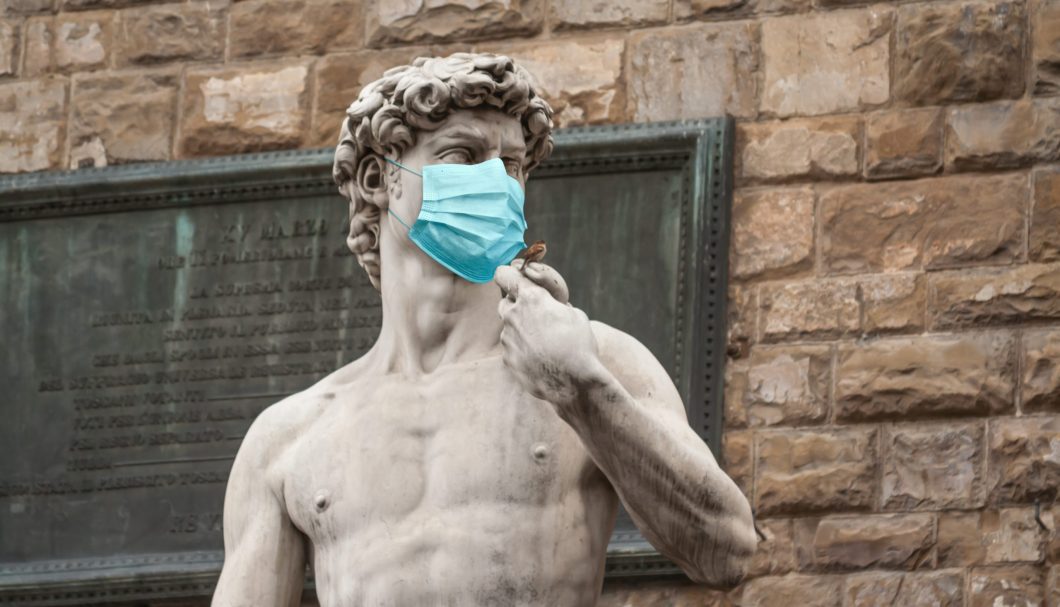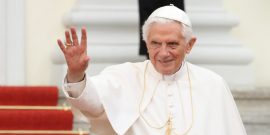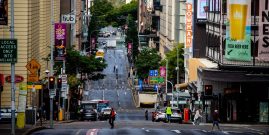In Islam: A Chronological Record, Fr. James V. Schall uncovers the West's ideological helplessness.
Humanity Beneath the Mask
There’s a moment in Delta Airlines’ new pandemic-era pre-flight video that depicts how to stay masked while drinking. If you’ve flown the airline anytime in the past couple years, you’ve probably seen it: two young women, side by side, are about to enjoy an inflight cocktail. They turn to each other. They clink their plastic cups. Then they face forward, pull down their masks to reveal their smiling faces, sip their drinks, and replace their face coverings. It all happens in perfect unison: a choreographed moment of connection, a spectacle of perfect compliance.
It is also utterly bizarre.
The camera cuts away after this, leaving the women to presumably repeat the unmask-sip-remask ritual until their drinks are gone, always making sure to stare straight ahead and smile as the mask comes back up. It also creates the eerie impression that maybe they never stop smiling at all, even with the mask on, their eyes fixed unblinking on the seatback ahead of them, their pretty white teeth gathering fuzz as they press up against the fabric. Either way, that brief moment of eye contact as they clink their cups is the closest they ever get to anything resembling the normal behavior of two friends traveling somewhere together. There’s no conversation, no connection, no leaning into the other’s space to share a moment of excitement about the journey to come.
That’s the thing about it: not just that it’s weird, but that it doesn’t feel human.
Of course, this has always been true of air travel in varying degrees. Shuffling bleakly through the security line like an extra from Metropolis, holding up your pants with one hand while they X-ray your belt for the third time, being intrusively patted in private places, watching like an impotent spectator as TSA agents rifle through your underwear in search of contraband. If you’ve ever stood shoeless in a security line, begging a smirking stranger to please, please not throw away your contact lens solution—an item which for some reason has still not been added to the list of medically-exempt liquids after twenty damn years—then you know what I mean when I say that the airport is a dehumanizing place. It’s hard not to feel diminished in these moments, realizing your powerlessness in the face of authority figures who see you as a problem, not a person, and who often seem to relish the act of taking you down a peg. There’s no point in complaining, of course; the TSA will simply insist that every indignity, every humiliation, is simply protocol, and then they’ll remind you that flying on an airplane is a privilege, not a right, which they’ll be all too happy to rescind if you don’t shut up and move along. Do you really want to miss your flight for this, let alone be escorted from the terminal in handcuffs and put on a list of Known Unruly Passengers?
But this used to be a temporary state of affairs that ended after the security line, and by the time you boarded the plane, it was nothing but a brief, bad memory.
And then came the pandemic, the masks, and the mandates.
Masks have become a point of immense contention since the pandemic began, imbued with a symbolic, cultural, political meaning that outstrips any question of their effectiveness.
It’s not just that wearing a mask across several hours and multiple altitude changes is uncomfortable (although it is), or that the mandates seem to be premised on the utterly nonsensical notion that covid, an airborne disease, politely stops circulating whenever drinks and snacks are served (although they are.) It’s how masking became the annoying sun around which the entire travel experience now orbits. The cabin crew, thrust into the role of mask police, treat every interaction with suspicion, like an act of non-compliance in the making; it’s like an entire cohort of service-oriented professionals have been replaced by a bunch of disgruntled substitute teachers who hate their jobs and hate you, too, whether or not you’ve done anything wrong. By the time the plane reaches cruising altitude, you’ve probably heard at least three separate times that mask-flouting passengers will be fined for noncompliance. If your mask slips beneath your nose while you sleep, expect to be shaken roughly awake and scolded; ditto if you take too long to eat that bag of pretzels without replacing your mask between bites. Videos of families being kicked off their flights because a sobbing toddler couldn’t keep his mask in place have become a genre unto themselves.
Taken alone, perhaps no single one of these incidents is a tragedy. But taken together, the effect on travel has been transformative, and not in a good way. Being forced to cover your face is unpleasant, but being treated like a walking disease vector is demeaning.
Masks have become a point of immense contention since the pandemic began, imbued with a symbolic, cultural, political meaning that outstrips any question of their effectiveness. This is unfortunate, because the greater the status of masks as a totem, the less anyone wants to discuss their usefulness as an intervention against the coronavirus. A cost-benefit analysis is out of the question; indeed, people tend to react with derision and hostility if you suggest that there might be costs at all.
And yet the costs exist, and persist, no matter how worthwhile the tradeoff might be. On the benefit side: certain masks, if worn consistently and correctly, will shield the wearer from infection with the coronavirus. But they also obscure our most expressive facial features, anonymize the wearer, and make it difficult to recognize the human being underneath. They obstruct communication. They hamper normal breath and speech. They exacerbate learning disabilities in children and isolate people with hearing loss. They set the bar for casual interaction so high that many people simply don’t bother, knowing that it will be a battle to make themselves understood. But as face coverings become non-optional, the drawbacks become less physical, and more about who we are—and what we might be losing. What happens to us when a stranger’s uncovered face becomes a source of fear? Who do we become when we see the sobbing toddler tearing at her mask, and can think only of how much virus she’s spewing into the air with every scream?
Throughout the pandemic, we’ve been assured that we’re all in this together: inside our homes, behind our masks, one big human family weathering the storm. But that sense of togetherness and cooperation is tenuous—and tends to dwindle in societies that become obsessed with compliance and coercion over cooperation. Teaching us to fear each other, to watch each other, to snitch when someone breaks the rules and celebrate when he’s punished: all of these things erode the trust that binds us. And left unchecked, they presage a future in which we no longer recognize each other’s humanity, whether we’re wearing masks or not.



